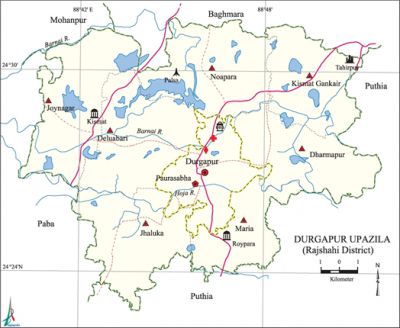Durgapur Upazila (Rajshahi District)
Durgapur Upazila (RAJSHAHI DISTRICT) area 197.89 sq km, located in between 24°23' and 24°32' north latitudes and in between 88°40' and 88°52' east longitudes. It is bounded by baghmara and mohanpur upazilas on the north, puthia upazila on the south and east, paba upazila on the west.
Population Total 185845; male 93551, female 92294; Muslim 180786, Hindu 4073, Christian 644 and others 342. Indigenous communities such as oraon and santals belong to this upazila.
Water bodies Hoja and Barnai rivers and' Angrar Beel, Kayamjampur Beel, Anulia Beel, Dahar Beel, Kaliar Padma Beel, Khaliar beel are notable.
Administration Durgapur Thana was formed in 1909 and it was turned into an' upazila in 1984.
| Upazila | ||||||||
| Municipality | Union | Mouza | Village | Population | Density (per sq km) | Literacy rate (%) | ||
| Urban | Rural | Urban | Rural | |||||
| 1 | 7 | 98 | 107 | 28119 | 157726 | 939 | 55.6 (2001) | 47.2 |
| Municipality | ||||||||
| Area (sq km) |
Ward | Mahalla | Population | Density (per sq km) |
Literacy rate (%) | |||
| - | 9 | 19 | 26671 | - | 55.0 | |||
| Upazila Town | ||||||||
|
Area (sq km) |
Mouza |
Population |
Density (per sq km) |
Literacy rate (%) | ||||
| 5.69 (2001) | 1 | 1448 | 1208 (2001) | 40.9 | ||||
| Union | ||||
| Name of union and GO code | Area (acre) | Population | Literacy rate (%) | |
| Male | Female | |||
| Kismat Gankair 59 | 5973 | 10670 | 10344 | 45.5 |
| Joynagar 47 | 7358 | 13857 | 13778 | 47.9 |
| Jhaluka 35 | 5958 | 12102 | 11586 | 43.2 |
| Deluabari 11 | 6797 | 12373 | 12302 | 46.8 |
| Dharmapur (Pananagar) 23 | 5261 | 8919 | 9039 | 51.5 |
| Noapara 83 | 7436 | 13923 | 13727 | 47.4 |
| Maria 71 | 3885 | 8370 | 8184 | 48.5 |
Source Bangladesh Population Census 2001 and 2011, Bangladesh Bureau of Statistics.

Archeological heritage and relics Kismat Mosque (Maria, eighteenth century), Roypara Jami Mosque (sixteenth century), Panchubari five domed Jami Mosque, Kali Mandir (Kalidaha), ruins of Neel Kuthi (Pananagar and Bakhtiarpur).
War of Liberation In 1971 a battle was fought between the freedom fighters and the Pak army at Kabasmul (Paba-Durgapur border) in which a Pak army Major was killed; in retaliation the agitated Pak army killed 44 innocent villagers of Gaganbaria and Palsa. Freedom fighters had an encounter with the Pak army at the Jhalmalia Bridge area on 12 April. Freedom fighters had another encounter with the enemy soldiers on 14 October at Hat Godagari in which 30 Pakistani soldiers were killed.
For details: see দুর্গাপুর উপজেলা, বাংলাদেশ মুক্তিযুদ্ধ জ্ঞানকোষ (Encyclopedia of Bangladesh War of Liberation), বাংলাদেশ এশিয়াটিক সোসাইটি, ঢাকা ২০২০, খণ্ড ৪।
Religious institutions Mosque 338, temple 14, church 1, sacred place 1. Noted religious institutions: Kismat Mosque (Maria), Roypara Jami Mosque, Panchubari Five Domed Jami Mosque, Kali Mandir (Kalidaha).
Literacy rate and educational institutions Average literacy 48.2%; male 52.2% female 44.3%. Educational institutions: College 9, technical college 3, secondary school 43, primary school 77, madrasa 19. Noted educational institutions: Durgapur Pilot High School (1946), Daudkandi High School (1946), Sreedhar Govt. Primary School (1857), Singa Govt. Primary School (1923).
Cultural organisations Library 1, club 25, theater group 1, cinema hall 1, women's organisation 1, playground 25.
Main sources of income Agriculture 79.85%, non-agricultural labourer 2.14%, industry 0.24%, commerce 7.92%, transport and communication 2.81%, service 3%, construction 0.45%, religious service 0.09%, rent and remittance 0.09% and others 3.41%.
Ownership of agricultural land Landowner 68.77%, landless 31.23%; agricultural landowner: urban 60.27%' and rural 69.11%.
Main crops Paddy, wheat, potato, betel nut, mulberry, vegetables.
Extinct or nearly extinct crops Sesame, mustard seed, sweet potato, kaun, linseed, arahar.
Main fruits Mango, jackfruit, banana, papaya, litchi, date.
Fisheries, dairies and poultries Fishery 50, poultry 20, hatchery 25.
Communication facilities Pucca road 201 km, semi-pucca road 9 km, mud road 428 km.
Extinct or nearly extinct traditional transport Palanquin, horse carriage and bullock cart.
Noted manufactories Flour mill, rice mill, saw mill, printing press, ice factory, welding factory, bidi factory.
Cottage industries Blacksmith, potteries, weaving, bamboo work.
Hats, bazars and fairs Hats and bazars are 16, fairs 3, most noted of which are Durgapur Bazar, Daudkandi Bazar, Pananagar Bazar, Kanpara Hat,' Baruni Snan Mela (Kalidaha), Tebila Muharram Mela (Pananagar), Lakshmipur Ghoradaha Mela.
Main exports Betel nut, banana, papaya, date molasses, flour, vegetables.
Access to electricity All the wards and unions of the upazila are under rural electrification net-work. However 54.5% of the dwelling households have access to electricity.
Sources of drinking water Tube-well 92.3%, tap 4.0% and others 3.7%.
Sanitation 56.0% of dwelling households of the upazila use sanitary latrines and 39.1% of dwelling households use non-sanitary latrines; 4.9% of households do not have latrine facilities.
Health centres Upazila health complex 1, health centre 7, family planning centre 7, satellite clinic 2, clinic 2.'
NGO activities brac, asa, caritas, thengamara mahila sabuj sangha, Barendra. [AKM Kaisaruzzaman]
References Bangladesh Population Census 2001 and 2011, Bangladesh Bureau of Statistics; Cultural survey report of Durgapur Upazila 2007.
